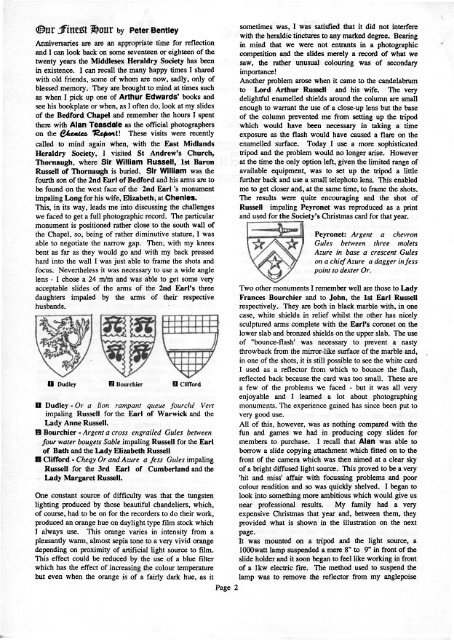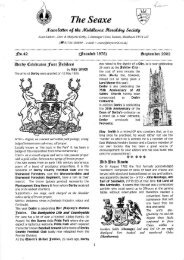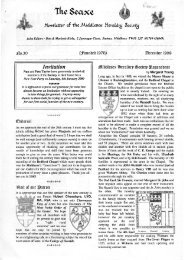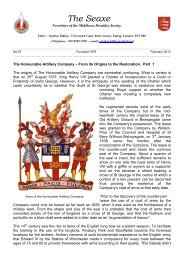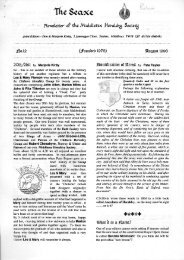The Seaxe - Middlesex Heraldry Society
The Seaxe - Middlesex Heraldry Society
The Seaxe - Middlesex Heraldry Society
Create successful ePaper yourself
Turn your PDF publications into a flip-book with our unique Google optimized e-Paper software.
Our Finest Hour by Peter Bentley<br />
Anniversaries are are an appropriate time for reflection<br />
and I can look back on some seventeen or eighteen of the<br />
twenty years the <strong>Middlesex</strong> <strong>Heraldry</strong> <strong>Society</strong> has been<br />
in existence. I can recall the many happy times I shared<br />
with old friends, some of whom are now, sadly, only of<br />
blessed memory. <strong>The</strong>y are brought to mind at times such<br />
as when I pick up one of Arthur Edwards' books and<br />
see his bookplate or when, as I often do, look at my slides<br />
of the Bedford Chapel and remember the hours I spent<br />
there with Alan Teasdale as the official photographers<br />
on the Chenies Report! <strong>The</strong>se visits were recently<br />
called to mind again when, with the East Midlands<br />
<strong>Heraldry</strong> <strong>Society</strong>, I visited St Andrew's Church,<br />
Thornaugh, where Sir William Russell, 1st Baron<br />
Russell of Thornaugh is buried. Sir William was the<br />
fourth son of the 2nd Earl of Bedford and his arms are to<br />
be found on the west face of the 2nd Earl's monument<br />
impaling Long for his wife, Elizabeth, at Chenies.<br />
This, in its way, leads me into discussing the challenges<br />
we faced to get a full photographic record. <strong>The</strong> particular<br />
monument is positioned rather close to the south wall of<br />
the Chapel, so, being of rather diminutive stature, I was<br />
able to negotiate the narrow gap. <strong>The</strong>n, with my knees<br />
bent as far as they would go and with my back pressed<br />
hard into the wall I was just able to frame the shots and<br />
focus. Nevertheless it was necessary to use a wide angle<br />
lens - I chose a 24 m/m and was able to get some very<br />
acceptable slides of the arms of the 2nd Earl's three<br />
daughters impaled by the arms of their respective<br />
husbands.<br />
1 Dudley 2 Bourchier<br />
3 Clifford<br />
1 Dudley - Or a lion rampant queue fourche Vert<br />
impaling Russell for the Earl of Warwick and the<br />
Lady Anne Russell.<br />
2 Bourchier - Argent a cross engrailed Gules between<br />
four water bougets Sable impaling Russell for the Earl<br />
of Bath and the Lady Elizabeth Russell<br />
3 Clifford - Chequy Or and Azure a fess Gules impaling<br />
Russell for the 3rd Earl of Cumberland and the<br />
Lady Margaret Russell.<br />
One constant source of difficulty was that the tungsten<br />
lighting produced by those beautiful chandeliers, which,<br />
of course, had to be on for the recorders to do their work,<br />
produced an orange hue on daylight type film stock which<br />
I always use. This orange varies in intensity from a<br />
pleasantly warm, almost sepia tone to a very vivid orange<br />
depending on proximity of artificial light source to film.<br />
This effect could be reduced by the use of a blue filter<br />
which has the effect of increasing the colour temperature<br />
but even when the orange is of a fairly dark hue, as it<br />
Page 2<br />
sometimes was, I was satisfied that it did not interfere<br />
with the heraldic tinctures to any marked degree. Bearing<br />
in mind that we were not entrants in a photographic<br />
competition and the slides merely a record of what we<br />
saw, the rather unusual colouring was of secondary<br />
importance!<br />
Another problem arose when it came to the candelabrum<br />
to Lord Arthur Russell and his wife. <strong>The</strong> very<br />
delightful enamelled shields around the column are small<br />
enough to warrant the use of a close-up lens but the base<br />
of the column prevented me from setting up the tripod<br />
which would have been necessary in taking a time<br />
exposure as the flash would have caused a flare on the<br />
enamelled surface. Today I use a more sophisticated<br />
tripod and the problem would no longer arise. However<br />
at the time the only option left, given the limited range of<br />
available equipment, was to set up the tripod a little<br />
further back and use a small telephoto lens. This enabled<br />
me to get closer and, at the same time, to frame the shots.<br />
<strong>The</strong> results were quite encouraging and the shot of<br />
Russell impaling Peyronet was reproduced as a print<br />
and used for the <strong>Society</strong>'s Christmas card for that year.<br />
Peyronet: Argent a chevron<br />
Gules between three molets<br />
Azure in base a crescent Gules<br />
on a chief Azure a dagger in fess<br />
point to dexter Or.<br />
Two other monuments I remember well are those to Lady<br />
Frances Bourchier and to John, the 1st Earl Russell<br />
respectively. <strong>The</strong>y are both in black marble with, in one<br />
case, white shields in relief whilst the other has nicely<br />
sculptured arms complete with the Earl's coronet on the<br />
lower slab and bronzed shields on the upper slab. <strong>The</strong> use<br />
of 'bounce-flash' was necessary to prevent a nasty<br />
throwback from the mirror-like surface of the marble and,<br />
in one of the shots, it is still possible to see the white card<br />
I used as a reflector from which to bounce the flash,<br />
reflected back because the card was too small. <strong>The</strong>se are<br />
a few of the problems we faced - but it was all very<br />
enjoyable and I learned a lot about photographing<br />
monuments. <strong>The</strong> experience gained has since been put to<br />
very good use.<br />
All of this, however, was as nothing compared with the<br />
fun and games we had in producing copy slides for<br />
members to purchase. I recall that Alan was able to<br />
borrow a slide copying attachment which fitted on to the<br />
front of the camera which was then aimed at a clear sky<br />
of a bright diffused light source. This proved to be a very<br />
'hit and miss' affair with focussing problems and poor<br />
colour rendition and so was quickly shelved. I began to<br />
look into something more ambitious which would give us<br />
near professional results. My family had a very<br />
expensive Christmas that year and, between them, they<br />
provided what is shown in the illustration on the next<br />
page.<br />
It was mounted on a tripod and the light source, a<br />
1000 watt lamp suspended a mere 8" to 9" in front of the<br />
slide holder and it soon began to feel like working in front<br />
of a 1kw electric fire. <strong>The</strong> method used to suspend the<br />
lamp was to remove the reflector from my anglepoise


